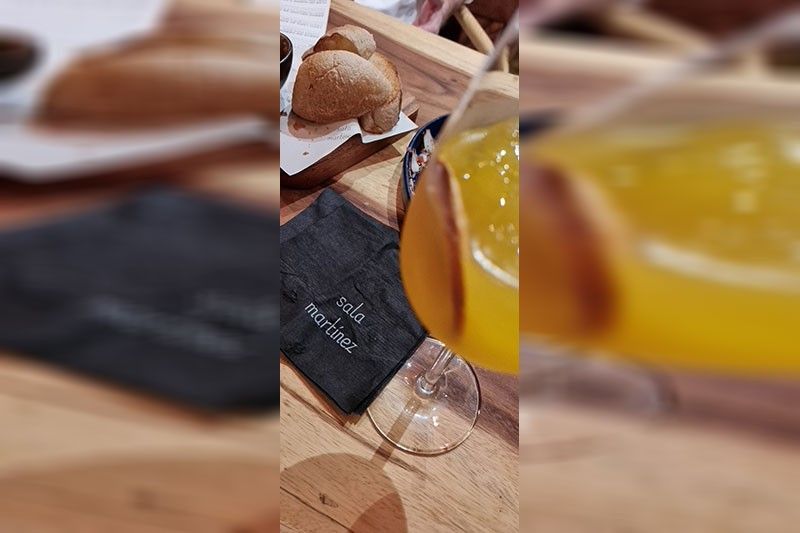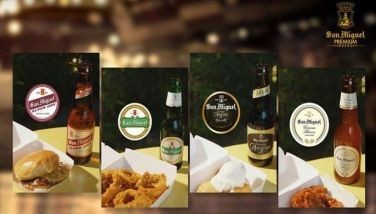A magic pan, paella for the soul

My soulmate Margie knows that when I am in a funk, three things spark joy (sorry, Marie Kondo), relieving a grumpiness unseen by many over the last few years. First, give me a hotdog, yes, the red tender juicy, a culinary enigma of mystery meat — this isn’t just any dog, it must be Jolly Hotdog. The next would be anything Chinese, a magical realm where flavors dance and twirl. A symphony, a riot of MSG that soothes the soul and a hangover. Yet, if there’s one dish that will put a smile on my sallow face, and a step in my pace — it must be the sun-kissed canvas of flavors, a vibrant masterpiece of grains, a mysterious trot of saffron — it is the paella, the classic valenciana treat that I fell in love with over 50 years ago.
In the late ‘70s, my dad’s younger brother Tony and his wife, Maruja, came to Manila from Sevilla on a visit. Daddy and Tito Tony had not seen each other in decades, and it was very much a homecoming to listen to stories of their youth and their journey. Tita Maruja, on the other hand, brought a paellera, and all the accouterments needed to make a paella. Manila was still a desert when it came to epicurean pursuits — there weren’t delis like Santi’s or Terry’s that we take for granted today. Olive oil, arroz bomba, saffron, chorizo and jamon jabugo were hard to come by. The quality was wanting. I was smitten by this magic pan, and since then I have made it my mission, so to speak, to make that elusive paella, done right. It was the ‘70s, Spanish kitchens like Alba (in those days, okay) made do with what was available, substituting time-worn ingredients for local favor.
Years later, I found the same paellera in the kitchen. We cleaned it up and oiled it and started, mostly by chance, on the steps in making one. It wasn’t till I picked up
Penolope Casas compendium Paella that I started to get the idea of technique and style. Casas’ book covered over 60 different recipes of this rice dish of robust flavors for easy, elegant entertaining. This book became my bible.
When Margie and I were newly married, we took our first long trip to Madrid, and it was a culinary journey that held its mark. We would have long lunches in spots that my grandparents dined at. La Barraca on C/Reina was as old school as you can get.

Photos of Ernest Hemingway and Clark Gable hung over our table. I asked to see the kitchen. I watched in awe, like a magic show, how a relatively simple dish continues to captivate 80 years of diners.
I bought my very own paellera at El Corte Ingles, Teflon-coated (I know, such heresy) and it’s been with me through our years living in San Francisco where I learned the intricacies of the paella, guided by Penolope Casas’ tome. With accessible ingredients, I made the valenciana, with artichokes, rabbit, and butter beans — no chorizo, mind you.
The paella was much of a crowd-pleaser in our entertaining years at home in Milbrae.
The pan came home with us when we were recalled back to Manila from our TFC days, where I continued to dabble and cook at our new flat in Rockwell. And when Margie and I took a break, I kept the paellera. Like the very first paella pan, I took it out of storage and brought it with me when Margie said I could come back to live with her.
We stopped entertaining as we got older, but I do take out the paellera every so often when I feel peckish. I picked up all the ingredients — arroz bomba and a good pimenton at Santi’s, when Jorge Joseph invited me to have lunch with Luis Martinez of Terraza Martinez at a new spot at Shangri-La Edsa Mall, Sala Martinez.

I first met Luis when I stumbled into Terraza Martinez when it was newly opened. This 38-year cook (he has no formal culinary training; hence he doesn’t like the moniker chef). He is a veterinarian by training and a cook by passion. He comes from Valencia (how perfect is that?) and grew up, like most Spanish families, around the kitchen. In this case, it was the large paella pan, which every Sunday pulled the family in preparing for the star of the day, preceded by cold beers, pica-pica and wanton idle chatter.
He worked long hours at Martinez Loriente, a leader in meat products for the European Union. The 16-hour days took their toll on the then 30-year-old. Martinez decided to pack his things and live a life on the wild in a country he only knew of from history and videos — he left his city life to move to Siargao. He dreamt of opening a small hotel, with a restaurant, to cater to the new breed of digital nomads who were making the surfing capital home. But COVID got in the way, and his savings, poured into the hotel, ran dry.
He had to find a way to keep going. He decided to cook, and opened Alma, his “soul” revitalized by cooking dishes from his home, as his mother would cook, and began his eight-year journey. Martinez, like all newcomers, especially living in a rough-and-tumble surf town, found it exceedingly arduous to find staff.
Being much of a “maniatico,” a finicky clean and process master (a sign of any good cook), he patiently trained his staff to clean as they go, addressing food safety, and his own pique, wastage. Alma and its young cook caught the eye of Carlo Lorenzana, of the Nikkei Group, who invited him to come to Manila to open a newly minted Spanish restaurant.
Luis wasn’t really sold on opening in Manila. He wanted to be a country bro, but he says the opportunity presented itself. He only asked that he had full control (a big ask) and that he could take breaks as he didn’t leave Spain just to be back in a peripatetic city.
He also came to a Manila that was experiencing decades-long renaissance in Castilian dining — where credit should be given to the Las Flores gang of Dani Aliaga, Uri Singla and Sergi Rostoll (all sold their shares to the Bistronomia group) and Chele Gonzalez of Gallery — for refreshing on how we saw Spanish food. A jaded Manila needed a reset. Its palate was so defined by our grandmother’s kitchen, Don Anastacio de Alba, Jesus Armas and perhaps Casino Español.
Unlike many before him, he doesn’t want to be a brand/celebrity chef, which most restaurant groups in the metropolis like to market. Luis doesn’t like the limelight, and with apprehension, sits with the press. He just likes working in the kitchen, watching his diners from a distance.
Sala Martinez at the new Streetscapes of Edsa Shangri-La Mall is a nice spot with ochre stucco walls, plush seating and basket drop lamps — a touch Martinez owes to his Siargao roots. Unlike Terraza, which is more Mediterranean in selection, he puts Sala as his ode to his hometown, Valencia. And the menu is just that.
He fired out of the kitchen a menu of restrained simplicity. Pulpo, or octopus, is common in restaurant menus, usually served smoked. Martinez presents it cold, in a carpaccio style with vinegar, lemon zest and cilantro. Almost a touch of Mexican. It was extremely refreshing in taste and presentation.
What stopped me at first bite was his interpretation of pig’s ears. He says it’s typical to his hometown, it was almost chicharon-like, drizzled with a roasted lemon and yet another twist on the vinaigrette.
His seafood dishes — a grilled lapu-lapu and a seafood stew in combination — reminded me of the days when I covered the Barcelona Olympics in 1994. During breaks, we went seaside, Pal Marquez (then our lead sports reporter and my partner in crime) and I would have grilled fish and arroz meloso — akin to a saffron stew with crab claws, prawns, squid, clams and arroz bomba. Luis served an aioli and togarashi to complement the strong saffron flavor.
But what made my heart beat fast was his paella valenciana. He admits it’s not authentic — lacking the garrofon or the butter beans (he uses French beans, and chicken instead of rabbit). What it lacks in ingredients it makes up in soul.
We continued to chat over agua de Valencia, a popular drink for the region made with oranges (of course!), cava, vodka, and gin. “I want more people to enjoy other drinks…not just sangria,” mused Martinez.
I went back to scrape off the remainder of the socarrat — the tutong — of the paella. When asked what makes a good arroz, he gets animated. “First you need good ingredients, preferably the right ones. Paella does not need many things.
But I noticed here that people like it filled with stuff. The simpler the better.” He continued, “a paella requires time, from preparing to cooking, it will be maybe 90 minutes — ah, in a restaurant we have ways to cut the time, but done at home, it is patience.” Luis also pointed out that a paella is all about technique. It is something that can be taught, but it needs practice and each one has his own way.
Then he paused. “The most important part of any arroz, a paella, is the sofrito!”A well-made sofrito for paella is a symphony of flavors, the dish’s very foundation.
It is a fragrant, golden elixir, simmered to perfection, with each ingredient contributing its unique character. The onions, sweet and tender, meld with the garlic, pungent and aromatic, while the tomatoes, ripe and juicy, add a rich, tangy depth.
A whisper of saffron, the gold of the Mediterranean, infuses the mixture with a delicate, floral note, while a pinch of paprika adds a smoky, earthy dimension.
The sofrito is the soul of the paella, the secret ingredient that elevates the dish from ordinary to extraordinary. It’s a testament to the artistry of Spanish cuisine, a masterpiece that has been perfected over a century.
The meal was a lot to take in, not just the copious amounts of saffron and paprika, but the emotions it brought back to me. I’ve had many paellas, and Luis has a place in my stomach. It is very, very good. I have often said that we may not remember what we ate, but we will remember how we feel. Like Luis, the lunch rekindled the spirit of a past long gone and, more so, my soul. The paellera, that pan, wields a certain grasp for the senses, and wherever I carried it was a reminder of all things magical.



















